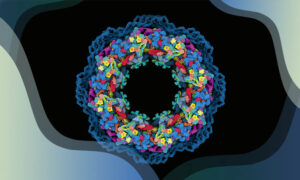Read the latest Issue
Need for speed
Molecular ticket determines RNA’s destination and speed inside egg cell
Like any law-abiding train passenger, a molecule called oskar RNA carries a stamped ticket detailing its destination and form of transport, scientists at the European Molecular Biology Laboratory (EMBL) in Heidelberg, Germany, have found. They show that for this molecule, moving in the right direction isn’t enough: speed is of the essence. Their study, published online today in Nature Structural & Molecular Biology, also provides clues as to how a single molecule could receive tickets for different destinations, depending on what type of cell it is in.
For a fruit fly embryo to develop properly, oskar RNA produced by the mother has to enter the egg cell, or oocyte, as it matures, and be taken to one of its ends – the posterior pole. Researchers in Anne Ephrussi’s group at EMBL have now found that this movement is more complicated than it seemed. When oskar is processed for transport by a mechanism called splicing, two different tags – SOLE and EJC – are attached to it, next to each other, at a specific spot. Ephrussi and colleagues found that both tags have to be in place for oskar to reach the right destination. Together, they seem to form a ticket that marks oskar for transport to the posterior pole, differentiating it from the many other RNAs that enter the oocyte bound for different destinations.
When they genetically altered the SOLE tag, the scientists found that oskar didn’t go to the oocyte’s posterior pole, as it should. But surprisingly, it did still move, and seemingly in the right direction. The problem, the researchers realised, was that oskar is racing towards a moving target. As the oocyte grows, it becomes longer, in effect taking the posterior pole further and further away as oskar is carried towards it. With a defective SOLE tag, oskar seemed unable to move fast enough to overcome the oocyte’s growth. So somehow this ‘ticket’ affects the speed of transport, too.
Ephrussi and colleagues are now investigating how SOLE and EJC interact with each other, and how they might influence the cellular machinery that transports oskar. The scientists would also like to explore an interesting possibility raised by their current findings. They discovered that the SOLE tag is only formed if the RNA molecule is spliced. Since some RNAs can be spliced at different spots along their length, this means the same RNA could potentially be issued with tickets for different destinations – for instance, in different cell types – depending on which parts of it are spliced.
Abstract
oskar RNA localization to the posterior pole of the Drosophila melanogaster oocyte requires splicing of the first intron and the exon junction complex (EJC) core proteins. The functional link between splicing, EJC deposition and oskar localization has been unclear. Here we demonstrate that the EJC associates with oskar mRNA upon splicing in vitro and that Drosophila EJC deposition is constitutive and conserved. Our in vivo analysis reveals that splicing creates the spliced oskar localization element (SOLE), whose structural integrity is crucial for ribonucleoprotein motility and localization in the oocyte. Splicing thus has a dual role in oskar mRNA localization: assembling the SOLE and depositing the EJC required for mRNA transport. The SOLE complements the EJC in formation of a functional unit that, together with the oskar 3′ UTR, maintains proper kinesin-based motility of oskar mRNPs and posterior mRNA targeting.







